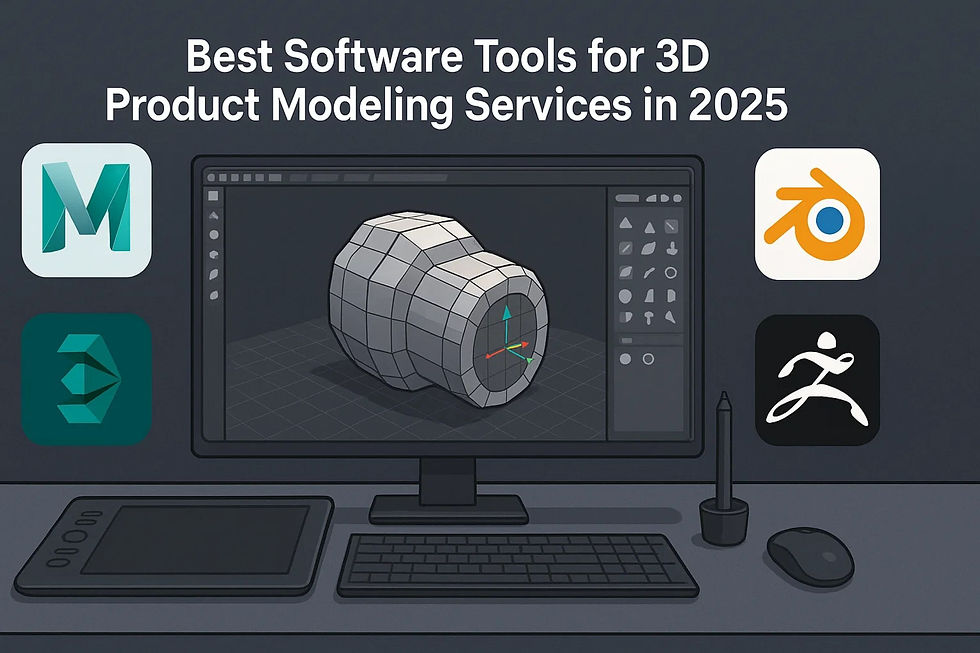Step-by-Step Guide: Creating a 3D Model Augmented Reality
- Hemant vizent
- Jun 12
- 5 min read

Step-by-Step Guide: Creating a 3D Model Augmented Reality
Augmented Reality (AR) is transforming how we interact with the digital world, seamlessly blending virtual objects into our physical environments. From trying on virtual sneakers to placing furniture in your living room, AR experiences are becoming increasingly common and sophisticated. But creating a 3D model specifically for Augmented Reality isn't the same as modeling for a static image or a video game. It requires a unique blend of artistic skill, technical optimization, and an understanding of AR's specific demands.
This guide will walk you through the essential steps to creating a 3D model optimized for Augmented Reality, helping you understand the nuances that make a virtual object truly convincing.
Step-by-Step Guide to Creating an AR-Ready 3D Model
Let's break down the process:
Step 1: Conceptualization and Reference Gathering
Before touching any software, clearly define what you're modeling and its purpose in AR.
What is the object? (e.g., a chair, a car, a building concept)
What is its real-world size? (Crucial for accurate AR scaling)
Gather References: Collect high-quality images, blueprints, and real-world examples of the object. Pay attention to every detail: dimensions, textures, materials, and how light interacts with it. This forms the blueprint for your 3D product modeling services work.
Step 2: 3D Modeling - Geometry Creation.
Choose Your Software: Popular choices include Blender (free, powerful), Autodesk Maya or 3ds Max (industry standard for complex models), SketchUp (good for architectural concepts), or even specialized tools if you're a 3D Model Maker for 3D Printer translating physical designs.
Block Out the Form: Start with basic primitive shapes (cubes, cylinders, spheres) to block out the main proportions and silhouette of your object.
Refine the Geometry: Add detail by extruding, subdividing, and sculpting. Maintain clean topology (well-organized polygons) as this impacts texturing and animation later.
Prioritize Efficiency: Unlike models for high-end rendering, aim for the lowest possible polygon count while retaining essential details and smooth curves. This is a key aspect of AR 3D Modeling. Unnecessary polygons bloat file size and impact performance.
Step 3: UV Unwrapping
UV unwrapping is like flattening a 3D object's surface into a 2D plane so you can paint textures onto it.
Unwrap: Use your 3D software's tools to "unwrap" the 3D mesh into a flat UV map.
Optimize UV Space: Arrange the unwrapped UV "islands" efficiently on the 2D canvas, maximizing texture resolution and minimizing wasted space. Avoid overlapping UVs unless absolutely necessary for specific effects. Proper UVs are crucial for realistic textures and efficient rendering for 3D Model Augmented Reality.
Step 4: Texturing - Adding Realism
This is where you add color, material properties, and surface details.
Physically Based Rendering (PBR) Workflows: This is the industry standard for realism. You'll typically create several maps:
Albedo/Base Color: The raw color of the surface.
Metallic: How metallic a surface is.
Normal Map: Simulates surface detail (bumps, dents) without adding actual geometry, crucial for performance.
Ambient Occlusion (AO): Simulates soft shadows where surfaces are close together.
Texture Painting/Generation: Use software like Substance Painter, Photoshop, or even your 3D software to create these PBR maps. You can also use real-world photos as a base.
Resolution: Choose appropriate texture resolutions (e.g., 2K or 4K) based on the object's size and how closely users will view it. Optimize texture formats (e.g., compressed PNG, JPG) for smaller file sizes, a vital consideration for AR 3D Modeling.
Step 5: Rigging (If Applicable)
Rigging: Create a skeletal "rig" (a hierarchy of bones) within your 3D model that allows parts to move realistically.
Skinning/Weight Painting: "Bind" the 3D mesh to the bones, defining how much each part of the mesh is influenced by the movement of a bone.
Step 6: Optimization for AR Deployment
This is arguably the most critical step for AR Product Visualization.
Polygon Reduction: Use tools to reduce the polygon count of your model without noticeably impacting visual quality.
Draw Calls & Materials: Minimize the number of unique materials (and thus draw calls) used in your model, as each material adds overhead.
Texture Compression: Compress your textures to reduce file size.
Scene Simplification: Remove any unnecessary hidden geometry or unused elements.
LODs (Levels of Detail): Implement LODs so that lower-polygon versions of your model are displayed when it's further away from the user.
Export Format: Export your model in an AR-friendly format like glTF/GLB (highly recommended for web AR), USDZ (for Apple ARKit), or FBX. These formats are optimized for real-time applications and can embed textures and animations. This specialized knowledge is part of professional 3D product modeling services.
Step 7: Testing in AR Environment
The final, crucial step:
Import into AR Platform: Load your 3D model into your chosen AR development platform (e.g., Apple ARKit, Google ARCore, Unity, WebAR solutions).
Test on Target Devices: Crucially, test the model on the actual devices (smartphones, tablets) that your target users will be using.
Assess Performance: Check for smooth frame rates, quick loading times, and realistic rendering.
Lighting and Shadows: Does it cast convincing shadows? Are its reflections believable? This iterative testing is what separates a good 3D Model Maker for 3D Printer from one specializing in AR.
When to Engage 3D Modeling Services
While this guide provides a roadmap, creating truly high-quality, optimized 3D models for AR is a specialized skill. Many businesses choose to engage professional 3D Modeling Services when:
High Volume Production: Converting an entire product catalog for AR Product Visualization.
Photorealistic Accuracy: Requiring extremely realistic models that are indistinguishable from real products.
Complex Geometry: Dealing with intricate designs or organic shapes.
Optimization Challenges: Needing expert optimization to ensure smooth performance on target devices.
Lack of In-house Expertise: When internal teams lack the specific skills in AR 3D Modeling or experience with VR 3D Modeling or Virtual Reality 3D Modeling (which shares many optimization principles).
Even if your primary goal is 3D Modeling for 3D Printing, the optimization techniques learned for AR are invaluable for creating cleaner, more efficient models across the board. The demand for a skilled 3D Model Maker for 3D Printer who also understands AR optimization is growing.
Conclusion
Creating a 3D Model Augmented Reality is a multi-faceted process that goes beyond basic 3D design. It demands precision in 3D product modeling services, a keen eye for realism, and rigorous optimization for real-time performance. By understanding the unique requirements of AR 3D Modeling – from efficient geometry and PBR textures to smart optimization techniques – you can create compelling 3D Model Augmented Reality experiences that captivate users and unlock the full potential of this transformative technology. Whether you do it yourself or leverage expert 3D Modeling Services, mastering these steps is the key to bringing your digital visions into the real world with stunning realism.





Comments